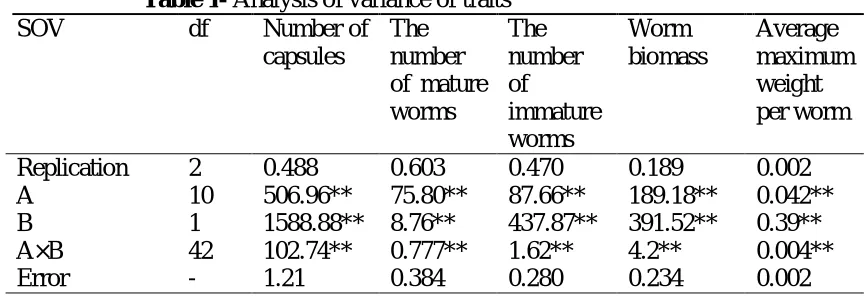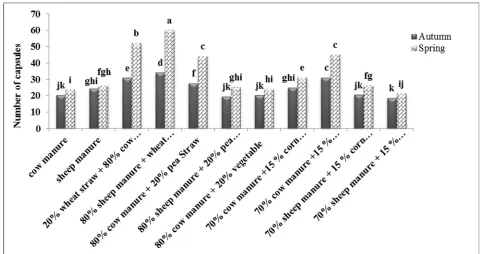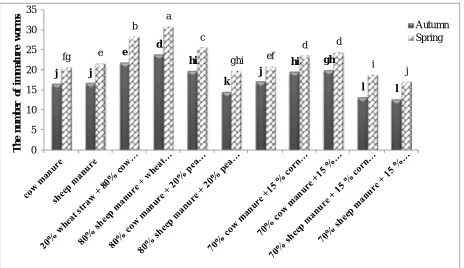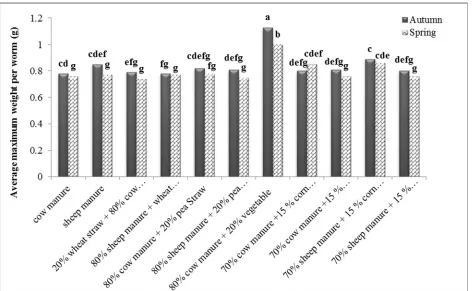International journal of Advanced Biological and Biomedical Research
Volume 1, Issue 11, 2013: 1368-1376
Effect of seasons and different substrates on growth and reproduction of the compost
worm Eisenia Fetida
Vahid Beyginiya1*, Mahmud Khoramivafa2, Farhood Yeganehpoor3, Farideh Samadiyan4
1
MS in Agroecology, University of Razi, Kermanshah, Iran.
2
Associate Prof Faculty of Agriculture, University of Razi Kermanshah, Iran.
3
Ph.D. Students in Agronomy, Faculty of Agriculture, University of Tabriz, Tabriz, Iran.
4
MS in Agriculture, Islamic Azad University, Esfahan, Iran.
ABSTRACT
The experiment was carried out in a factorial arrangement with the base of randomized complete block design in three repetitions. The first factor consisted of 11 bed for eating worm and the second factor is the different seasons (spring and autumn) respectively. Traits was including number of capsules (Coconut), the number of adult worms, the number of immature worms, live worms masses (mg), maximum weight per worm (mg) and the average number of outgoing cases per capsule (Coconut), respectively.The results showed that the interaction between the incubator × seasons was significant for all traits. So the highest average in 80% sheep manure + wheat straw 20% was observed in the spring. It was conclude that changes in different contexts breeding seasons and has a great effect on the measured traits Maximum biomass, maximum activity was obtained in the spring mating and the number of capsules and the season tiny capsules Unexpectedly a winter was produced by the adult worm.
Keywords: Environment, E. fetida worm and worm biomass.
1- INTRODUCTION
experiment are due to different seasons and different substrates on the growth and reproduction of the compost worm Eisenia fetida mechanisms are examined.
2- MATERIALA AND METHODS
This experiment was carried out in the company milk and livestock Kangavar, located Kangavar located in Kermanshah province, 10 kilometers East of the city Kangavar the geographical 47° 82'- 48° 06' eastern longitude and geo 34° 43'- 34° 56' North has been implemented. An altitude of 1470 meters above sea level and the average annual rainfall in the region 395.1 mm in year. The city's cold climate is semi-arid with an average annual is temperature of 13.3 ° C in 2012. The following table of statistics for
climate research has shown that where the experiment took place. The experiment was carried out in a
factorial arrangement with the base of randomized complete block design in three replications.The first factor consisted of bed for eating worm (includes: 1 - cow manure, 2 - sheep manure, 3 - 20% wheat straw + 80% cow manure 4 - 80% sheep manure + wheat straw 20%, 5 - 80% cow manure + 20% pea Straw, 6 - 80% sheep manure + 20% pea straw, 7 - 80% cow manure + 20% Fruit and vegetable waste 8 - 70% cow manure +15% corn straw + 15% Sawdust, 9 - 70% cow manure +15% Glycyrrhizin glare + 15% wheat straw, 10 - 70% sheep manure + 15% corn straw + 15% cardboard waste and 11 - 70% sheep manure + 15% Glycyrrhizin labra + 15% Sawdust) and the second factor is the different seasons (spring and autumn), respectively. The traits measured included the number of capsules (Coconut); the number of adult worms was the number of immature worms, live worms masses (mg), maximum weight per worm (mg) and the average number of outgoing cases per capsule (Coconut). Remnants of industrial and agricultural waste require factories and workshops were prepared. Inscription from the industrial town of pulp, manure, wheat straw, corn remains the company's website vermicomposting residues in milk and animal Kangavar pea straw market selling vegetables from the vegetable waste Kermanshah city Kangavar and sawdust from the shop Kangavar sawmills located in the city was prepared . Numbering about a thousand pairs of worm compost maker (E. foetida) stack of vermicomposting dairy and livestock Kangavar were collected participate. And a plastic container that contains small amounts of material was transferred to the substrate. In order to establish proper drain out excess water, drill a hole through the bottom of plastic containers. Before filling the bucket with the desired substrates, livestock manure and other raw materials, substrates, chopped into smaller size. The material produced per certain weight and weighing each treatment was pooled. The mixing was done manually and evenly. Minimum height of 25 cm was filled with useful materials. Plastic floor drain partly out of the water, the water was completely soaked. For each container, 10 pieces of worm composting formed it maker, mature sex ring was removed and weighed and then added to each dish 33.10 cream 5 g weight was considered. In order to accurately weighed, then washed with water and then with a dry cloth worms were placed on the weighing scales, worms were placed on the substrate surface. After entering into the worm beds, beds were watered with distilled water. For each dish separately with rushing for entering into the bed flies and spawn, they were wearing. Plastic containers were placed in a suitable environment for open and fully covered with two layers of Hemp Sack. On the likelihood of heavy rains and the long-term addition, a layer of plastic bags were pulled on them. Bed weeks depending on environmental conditions alike of water were sprayed 1-2 times. All the steps were carried out in spring and fall alike and it continued till 110 days. Testing of 15 April began at the site in spring and the first sampling date was 10 May month. Sampling took place later
in the timeline above. The site began Fall 10 September and 5 October first biopsy was performed. At the
end of each period mechanism capsule Eisenia foetida by hand from materials inside the plastic container was removed and after washing and drying, counted and weighed. Then the test data normality, 11×2
factorial analysis of variance is investigated. Significance between means was tested using Duncan
significant. MSTATC and 16 SPSS software using statistical calculations and plotting graphs were done using EXCEL software.
3- RESULTS AND DISCUSSION
Analysis of variance of the data showed significant effects of seasons (spring and autumn) and bed for eating worm on number of capsules, the number of adult worms, the number of immature worms, worm biomass and average maximum weight per worm.Significant (p≤0.05) seasons × bed for eating worm interaction on number of capsules, the number of mature worms, the number of immature worms, worm biomass and average maximum weight per worm were observed (Table 1).
Table 1- Analysis of variance of traits
Average maximum weight per worm Worm biomass The number of immature worms The number of mature worms Number of capsules df SOV 0.002 0.189 0.470 0.603 0.488 2 Replication 0.042** 189.18** 87.66** 75.80** 506.96** 10 A 0.39** 391.52** 437.87** 8.76** 1588.88** 1 B 0.004** 4.2** 1.62** 0.777** 102.74** 42 A×B 0.002 0.234 0.280 0.384 1.21 - Error
* and ** are significant at 5 and 1 % probability levels, respectively
substrate material is higher than the growth of worms. The maximum average maximum weight per worm in treatment 80% cow manure + 20% Fruit and vegetable waste in the spring and in the 70% sheep manure + 15 % Glycyrrhizins glare + 15% Sawdust was implemented in the autumn to lowest number of manure worms indicated (Fig. 5). Factor was in increased weight of the worm for the food and the environment. Domínguez et al (2003) reported an average daily weight of the worm depends on the density, population and food.
4- CONCLUSION
The highest average in 80% sheep manure + wheat straw 20% was observed in the spring. From
the results the present study it can be conclude that changes in different contexts breeding seasons and has a great effect on the measured traits Maximum biomass, maximum activity was obtained in the spring mating and the number of capsules and the season tiny capsules Unexpectedly a winter was produced by the adult worm.
Fig 1 - Comparison of the mean number of capsules in two seasons (autumn and spring) with different substrates vermicompost.
ij ij
d bc
e ij j f e ij k
g fg
b
a
cd
g i
e cd
f ij 0 5 10 15 20 25 T h e n u m b er o f m a tu re w o rm s Autumn Spring
Fig 2 - Comparison of the mean the number of mature worms in two seasons (autumn and spring) with different substrates vermicompost.
j j
e d
hi
k j
hi gh
l l
fg e
b a
c
ghi ef
d d
Fig 4 - Comparison of the mean the worm biomass in two seasons (autumn and spring) with different substrates vermicompost.
REFERENCES
Albuzio A, Concheri G, Nardi S, Dell’Agnola G (1994). Effect of humic fractions of different molecular size on the development of oat seedlings grown in varied nutritional conditions. In: Senesi, N.,Mianom, T.M. (Eds.), Humic Substances in the Global Environment and Implications on Human Health. Elsevier Science, Amsterdam, pp. 199–204.
Atiyeh RM, Dominguez J, Subler S, Edwards CA (2000). Changes in biochemical properties of cow manure during processing by earthworms (Eisenia andrei) and the effects on seedling growth. Pedobiologia 44, 709–724.
Casenave de Sanfilippo E, Arguello JA, Abdala G, Orioli GA (1990). Content of Auxin-, inhibitor- and Gibberellin-like substances in humic acids. Biologia Plantarum 32, 346–351.
Cavender ND, Atiyeh RM, Edwards CA (1999). Influence of vermicomposts on arbuscular mycorrhizal infection of Sorghum bicolor and plant growth. In: 2nd International Soil Ecology Conference Abstract, Chicago, Il, p. 23.
Chen Y, Aviad T (1990). Effects of humic substances on plant growth. In: McCarthy, P., Clapp, C.E., Malcolm, R.L., Bloom, P.R. (Eds.), Humic Substances in Soil and Crop Sciences: Selected Readings. ASA and SSSA, Madison, WI, pp. 161–186.
Dell’Agnola G, Nardi S (1987). Hormone-like effect and enhanced nitrate uptake induced by depolycondensed humic fractions obtained from Allolobophora rosea and A. caliginosa faeces. Biology and Fertility of Soils 4, 115–118.
Domínguez J, Velando J, Aira M, Monroy F (2003). Uniparental reproduction of Eisenia fetida and E. Andrei (Oligochaeta: Lumbricidae): evidence of self-insemination. Pedobiologia. No. 47. pp.530-534 Doube BM, Williams PML, Willmott PJ (1997). The influence of two species of earthworm (Aporrectodea trapezoides and Aporrectoedea rosea) on the growth of wheat, barley and faba beans in three soil types in the greenhouse. Soil Biology and Biochemistry 29, 503–509.
Elvira C, Sampedro L, Benitezm E, Nogales R (1998). Vermicomposting of sludges from paper mill and dairy industries with Eisenia andrei: a pilot-scale study. Bioresource Technology 63, 205–211.
Evans AC, Guild WJ (1948). Studies on the relationships between earthworms and soil fertility. V. Field population. Ann. Appl. Biol. 35, 485-493.
Fernandez LLC, Rojas ANG, Carrillo RTG, Islas RME, Martinez ZHG, Hernandez UR, Avila RJR, Hernandez FD, Ortega AJM (2006). Manual of analysis techniques of soils applied to remediation of polluted places. SEMARNAT, INE, IMP. 177p.
Kahsnitz HG (1992). Investigations on the influence of earthworms on soil and plant. Botanical Archives 1, 315–331.
Kale RD (1998). Earthworms:nature’s gift for utilization of organic wastes. In: Edwards, C.A. (Ed.), Earthworm Ecology. CRC Press, Boca Raton, FL, pp. 355–377.
Krishnamoorthy RV, Vajranabhiah SN (1986). Biological activity of earthworm casts: An assessment of plant growth promotor levels in casts. Proceedings of the Indian Academy of Sciences (Animal Science) 95, 341–351.
Mylonas VA, Mccants CB (1980). Effects of humic and fulvic acids on growth of tobacco. I. Root initiation and elongation. Plant and Soil 54, 485–490.
Nakamura Y (1996). Interactions between earthworms and microorganisms in biological control of plant root pathogens. Farming Japan 30, 37–43.
Phuong HK, Tichy V (1976). Activity of humus acids from peat as studied by means of some growth regulator bioassays. Biologia Plantarum 18, 195–199.
Subler S, Edwards CA, Metzger JD (1998). Comparing vermicomposts and composts. BioCycle 39, 63– 66.
Suthar S (2009). Vermicomposting of vegetable-market solid waste using Eisenia fetida: Impact of bulking material on earthworm growth and decomposition rate. Ecology Enginery. 35: 914-920.
Tan KH, Tantiwiramanond D (1983). Effect of humic acids on nodulation and dry matter production of soybean, peanut, and clover. Soil Science Society of America Journal 47, 1121–1124.
Thankamani CK, Sivaraman K, Kandiannan K (1996). Response of clove (Syzygium aromaticum (L.) Merr. & Perry) seedlings and black pepper (Piper nigrum L.) cuttings to propagating media under nursery conditions. Journal of Spices and Aromatic Crops 5, 99–104.



